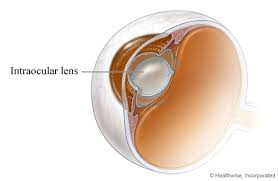Intraocular lenses (IOLs) are medical lenses that are implanted inside the eye to replace the eye’s natural lens when it is removed during cataract surgery. Today there is a wide variety of premium IOLs to choose from. The best IOL for you depends on many factors, including your lifestyle and your specific visual needs. Your Cataract Surgeon can help you choose the best IOL for you.
What are the type of lenses (IOLs) ?
There are hard lenses (Non Foldable) and soft lenses (foldable). Soft lenses can be Monofocal or Multifocal.
Conventional spherical IOLs are monofocal lenses, meaning they are designed to provide clear vision at a single focal point (usually far away, for good driving vision, for example). With conventional IOLs, one typically needs eyeglasses or contact lenses in order to use a computer, read or perform other close-up tasks within arm’s length.
Multifocal IOLs contain added magnification in different parts of the lens to expand your range of vision so you can see objects clearly at all distances without glasses or contact lenses.
Will I need to use glasses after the Cataract Surgery ?
Reading glasses are a must with monofocal IOL’s, and a small power might be needed even for the distance.
With multifocal IOLs, the patients are able to do most of their near and distance activities without glasses. But for finer observation, glasses may be needed.
How is the quality of vision different in the monofocal & multifocal IOLs ?
The quality of vision (in terms of the contrast sensitivity) Is better in monofocal IOLs compared to the multifocal IOLs.
What is the life of an IOL? Can there be a situation requiring IOL to be changed ?
Irrespective of the material of the IOL, other technical specifications, and the age of the patient at the time of the surgery, the IOL is meant to last for the lifetime of the patient. An IOL might need to be removed or changed In very rare scenarios (e.g- dislocated IOL, wrong power calculation) only.
What are the latest developments in the IOL?
Apart from the features already discussed, we now have the premium lenses – such as Aspheric, Toric and Multifocal Toric IOLs.
The spherical optical design of the traditional intraocular lenses does not mimic the shape of the natural lens inside the eye, which varies in curvature from center to periphery. This impacts the quality of vision, particularly in the low-light conditions. Premium aspheric IOLs, on the other hand, match more closely the shape and optical quality of the eye’s natural lens, and can thereby provide sharper vision — especially in low light conditions and for people with large pupils.
Toric IOLs are premium lenses that are meant to correct the pre-existing Cylindrical power also. They have different powers in different meridians of the lens for that. They also have alignment markings on the peripheral part of the lens that enable the surgeon to adjust the orientation of the IOL inside the eye for optimal astigmatism correction. These lenses are expensive with the base package of around Rs 50,000 (i.e. 800 USD)
Accommodating IOL’s are also beginning to be available now – though their results are not as predictable.
How is the quality and cost of an IOL determined ?
IOLs differ in their material (hydrophilic / hydrophobic / silicon) and in their technical specification (surface Asphericity, Blue filter, autoglistening surface etc). A lower-end IOL would have a hydrophilic material and a non-aspheric surface. In contrast, a higher-end IOL would have a hydrophobic material with an aspheric surface, blue filter and autoglistening property.
How much does a cataract operation cost ?
The price of the Cataract Surgery depends upon the IOL specification, Surgeon’s expertise level, and clinic’s brand value. It normally ranges between Rs 12,000 and 1,00,000 (i.e. 200 – 1500 USD).
Is this surgery covered under Mediclaim ?
Cataract surgery is covered under mediclaim for Cashless services. The limit of coverage may vary from one Insurance company to another and from one policy to another. Majority of the Insurance companies provide coverage for a monofocal & Non-Toric IOL. In case a patient plans for a premium IOL, the difference in cost has to be borne by the patient.
Dr. Maneesh Aggarwal [MBBS, MS, DNB, MNAMS], Senior Cataract Surgeon and Ophthalmologist

